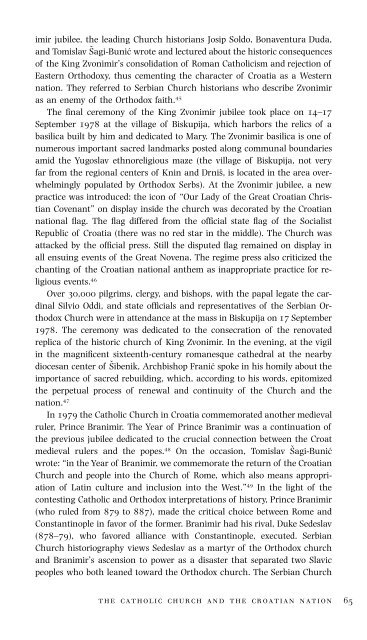Balkan Idols: Religion and Nationalism in Yugoslav States
Balkan Idols: Religion and Nationalism in Yugoslav States
Balkan Idols: Religion and Nationalism in Yugoslav States
Create successful ePaper yourself
Turn your PDF publications into a flip-book with our unique Google optimized e-Paper software.
imir jubilee, the lead<strong>in</strong>g Church historians Josip Soldo, Bonaventura Duda,<br />
<strong>and</strong> Tomislav S ˇ agi-Bunić wrote <strong>and</strong> lectured about the historic consequences<br />
of the K<strong>in</strong>g Zvonimir’s consolidation of Roman Catholicism <strong>and</strong> rejection of<br />
Eastern Orthodoxy, thus cement<strong>in</strong>g the character of Croatia as a Western<br />
nation. They referred to Serbian Church historians who describe Zvonimir<br />
as an enemy of the Orthodox faith. 45<br />
The f<strong>in</strong>al ceremony of the K<strong>in</strong>g Zvonimir jubilee took place on 14–17<br />
September 1978 at the village of Biskupija, which harbors the relics of a<br />
basilica built by him <strong>and</strong> dedicated to Mary. The Zvonimir basilica is one of<br />
numerous important sacred l<strong>and</strong>marks posted along communal boundaries<br />
amid the <strong>Yugoslav</strong> ethnoreligious maze (the village of Biskupija, not very<br />
far from the regional centers of Kn<strong>in</strong> <strong>and</strong> Drnisˇ, is located <strong>in</strong> the area overwhelm<strong>in</strong>gly<br />
populated by Orthodox Serbs). At the Zvonimir jubilee, a new<br />
practice was <strong>in</strong>troduced: the icon of “Our Lady of the Great Croatian Christian<br />
Covenant” on display <strong>in</strong>side the church was decorated by the Croatian<br />
national flag. The flag differed from the official state flag of the Socialist<br />
Republic of Croatia (there was no red star <strong>in</strong> the middle). The Church was<br />
attacked by the official press. Still the disputed flag rema<strong>in</strong>ed on display <strong>in</strong><br />
all ensu<strong>in</strong>g events of the Great Novena. The regime press also criticized the<br />
chant<strong>in</strong>g of the Croatian national anthem as <strong>in</strong>appropriate practice for religious<br />
events. 46<br />
Over 30,000 pilgrims, clergy, <strong>and</strong> bishops, with the papal legate the card<strong>in</strong>al<br />
Silvio Oddi, <strong>and</strong> state officials <strong>and</strong> representatives of the Serbian Orthodox<br />
Church were <strong>in</strong> attendance at the mass <strong>in</strong> Biskupija on 17 September<br />
1978. The ceremony was dedicated to the consecration of the renovated<br />
replica of the historic church of K<strong>in</strong>g Zvonimir. In the even<strong>in</strong>g, at the vigil<br />
<strong>in</strong> the magnificent sixteenth-century romanesque cathedral at the nearby<br />
diocesan center of S ˇ ibenik, Archbishop Franić spoke <strong>in</strong> his homily about the<br />
importance of sacred rebuild<strong>in</strong>g, which, accord<strong>in</strong>g to his words, epitomized<br />
the perpetual process of renewal <strong>and</strong> cont<strong>in</strong>uity of the Church <strong>and</strong> the<br />
nation. 47<br />
In 1979 the Catholic Church <strong>in</strong> Croatia commemorated another medieval<br />
ruler, Pr<strong>in</strong>ce Branimir. The Year of Pr<strong>in</strong>ce Branimir was a cont<strong>in</strong>uation of<br />
the previous jubilee dedicated to the crucial connection between the Croat<br />
medieval rulers <strong>and</strong> the popes. 48 On the occasion, Tomislav S ˇ agi-Bunić<br />
wrote: “<strong>in</strong> the Year of Branimir, we commemorate the return of the Croatian<br />
Church <strong>and</strong> people <strong>in</strong>to the Church of Rome, which also means appropriation<br />
of Lat<strong>in</strong> culture <strong>and</strong> <strong>in</strong>clusion <strong>in</strong>to the West.” 49 In the light of the<br />
contest<strong>in</strong>g Catholic <strong>and</strong> Orthodox <strong>in</strong>terpretations of history, Pr<strong>in</strong>ce Branimir<br />
(who ruled from 879 to 887), made the critical choice between Rome <strong>and</strong><br />
Constant<strong>in</strong>ople <strong>in</strong> favor of the former. Branimir had his rival, Duke Sedeslav<br />
(878–79), who favored alliance with Constant<strong>in</strong>ople, executed. Serbian<br />
Church historiography views Sedeslav as a martyr of the Orthodox church<br />
<strong>and</strong> Branimir’s ascension to power as a disaster that separated two Slavic<br />
peoples who both leaned toward the Orthodox church. The Serbian Church<br />
the catholic church <strong>and</strong> the croatian nation 65


